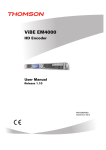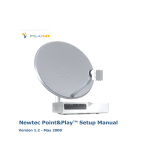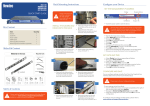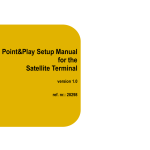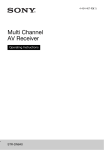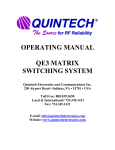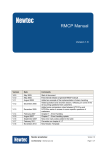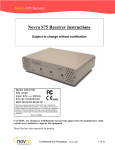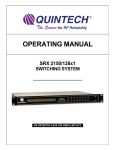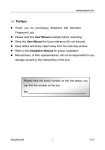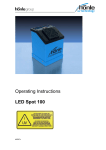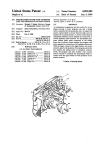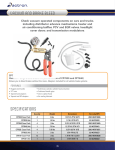Download Implementing 1+1 RF Redundancy with the SMD-989
Transcript
Implementing 1+1 RF Redundancy with the SMD-989 Application Note December 2011 Page 1 (10) www.sencore.com | 1.605.978.4600 Revision 1.0 Implementing 1+1 RF Redundancy with the SMD-989 – © 2011 Sencore, Inc. – Application Note Copyright © 2011 Sencore, Inc. All rights reserved. 3200 Sencore Drive, Sioux Falls, SD USA www.sencore.com This publication contains confidential, proprietary, and trade secret information. No part of this document may be copied, photocopied, reproduced, translated, or reduced to any machine-readable or electronic format without prior written permission from Sencore. Information in this document is subject to change without notice and Sencore Inc. assumes no responsibility or liability for any errors or inaccuracies. Sencore, Sencore Inc, and the Sencore logo are trademarks or registered trademarks in the United States and other countries. All other products or services mentioned in this document are identified by the trademarks, service marks, or product names as designated by the companies who market those products. Inquiries should be made directly to those companies. This document may also have links to third-party web pages that are beyond the control of Sencore. The presence of such links does not imply that Sencore endorses or recommends the content on those pages. Sencore acknowledges the use of third-party open source software and licenses in some Sencore products. This freely available source code can be obtained by contacting Sencore Inc. About Sencore Sencore is an engineering leader in the development of high-quality signal transmission solutions for the broadcast, cable, satellite, IPTV, and telecommunications markets. The company's world-class portfolio includes video delivery products, system monitoring and analysis solutions, and test and measurement equipment, all designed to support system interoperability and backed by best-in-class customer support. Sencore products meet the rapidly changing needs of modern media by ensuring the efficient delivery of high-quality video from the source to the home. More information about Sencore is available at the company’s website, www.sencore.com. All trademarks and registered trademarks mentioned herein are the property of their respective owners. Page 2 (10) Revision 1.0 Implementing 1+1 RF Redundancy with the SMD-989 – © 2011 Sencore, Inc. – Application Note Table of Contents 1 Introduction ......................................................................................................................................................... 4 2 Redundancy System Configuration .................................................................................................................... 5 2.1 Redundancy System Overview ............................................................................................................. 5 2.2 Specific Considerations when Configuring an RF Redundancy System ............................................ 5 3 Failover Triggers .................................................................................................................................................. 7 3.1 Failover on Power Loss ......................................................................................................................... 7 3.2 Failover on Input Status or Unit Errors ................................................................................................ 7 4 Example System Configuration .......................................................................................................................... 8 5 Qualified Equipment List .................................................................................................................................... 9 Page 3 (10) Revision 1.0 Implementing 1+1 RF Redundancy with the SMD-989 – © 2011 Sencore, Inc. – Application Note 1 Introduction Satellite modulators sit at a critical point in the delivery chain for a video distributor. When a satellite link goes down, thousands, or even millions, of customers can lose their video feed. Telephones from the provider's customer service center all the way up to the network operations center will begin ringing, and a mad scramble to diagnose and repair the issue will kick off in no time. While Sencore designs its modulators to operate reliably, consistently, and free of issues for years, many distributors prefer to build an extra layer of reliability into their broadcast systems through the use of redundant equipment. This application note outlines an example of a redundant system installation using the Sencore SMD 989 modulator. The particular redundancy scenario illustrated in this document operates at the RF (L-Band) layer of the distribution system, and involves two redundant, identically configured SMD 989 modulators. As such, it is referred to as "1+1 RF Redundancy." Sencore does not currently manufacture RF redundancy switches. Sencore's focus thus far has been on providing modulators with the best possible signal quality, most useful feature set for video distributors, and quickest, most straightforward set-up and operation. Sencore has, however, qualified several thirdparty RF redundancy switches for use with our DVB-S/S2 modulator. Redundancy switch design may seem outwardly simple, but the switch's positioning as a single point of failure in the broadcast chain requires that it be designed with a high degree of reliability and robustness in mind. The switches discussed in this system embody these qualities, and have been qualified as compatible with the SMD 989. In addition, they provide the proper interfaces for maximum system redundancy when coupled with the SMD 989. Page 4 (10) Revision 1.0 Implementing 1+1 RF Redundancy with the SMD-989 – © 2011 Sencore, Inc. – Application Note 2 Redundancy System Configuration 2.1 Redundancy System Overview A basic overview of a 1+1 RF redundancy system is shown in Fig. 2-1 below. It focuses on three pieces: two modulators and a redundancy switch. Many redundant broadcast systems have additional redundancy built all the way "up the chain" to the video encoder. However, as the focus of this paper is on redundancy in satellite modulation, those pieces are not shown in the figure. Transport Stream Input (ASI or IP) SMD 989 DVB-S/S2 Modulator (Primary) Relay Closure Signal (Optional) L-Band RF Signal Transport Stream Input (ASI or IP) Third Party RF Redundancy Switch L-Band RF Signal SMD 989 DVB-S/S2 Modulator (Backup) Fig. 2-1: Diagram of 1+1 RF Redundancy System with Two Modulators and Redundancy Switch 2.2 Specific Considerations when Configuring an RF Redundancy System There are several important considerations to note when configuring and selecting components for a system such as this one. Modulator Input: The input feeds to the two modulators should be identical. In the case of ASI video inputs, the two inputs are typically fed from identical links of a fully redundant system, or generated by a distribution amplifier or signal router. In the case of MPEG-TS over IP, the two modulators should be subscribed to identical multicasts, and may possibly be fed by separate network segments. Modulator Configuration: In order for the failover experience between the two units to be as seamless as possible, the two modulators should be identically configured with regard to modulation parameters. One exception to truly identical modulator configuration may be the IP addresses for the units' Ethernet interfaces. If the units are connected to the same network, these IP addresses will be different. Unit Profiles: The Sencore Unit Profile Feature can be used to achieve identical unit configuration. Profiles are human-readable text files which can be downloaded from an SMD, and contain all settings for the unit. The profile can be applied to the backup unit to ensure identical modulator setup. Also, if a unit should need to be physically replaced, the profile can be applied to that replacement unit. Note: Sencore profiles exclude unit IP addresses by default, and can be applied safely to two units on the same network. Redundancy Switch Connection: The redundancy switches suggested in this document have support for the full range of L-Band signals. However, some switches support only a limited frequency band, so it is important to check the supported frequency range when considering a switch. Additionally, there are a few other important items to note with regard to the modulator output. 1. Most redundancy switches do not support pass through of BUC/DC/LNB power. If power on the LBand output is required, it may be necessary to inject that power after the redundancy switch. 2. The same consideration applies to other signals which may be coupled onto the L-Band cable, such as a 10MHz reference clock. Page 5 (10) Revision 1.0 Implementing 1+1 RF Redundancy with the SMD-989 – © 2011 Sencore, Inc. – Application Note 3. As always when connecting RF transmission components, the L-Band cable should be impedance matched. This may require a matching pad between the modulator and the switch. The SMD 989's L-Band output is a 50 Ohm SMA connector. L-Band Failover: The redundancy switches in this document will monitor the L-band input from the modulator and trigger a failover to the backup input signal if that input disappears. An overview of this behavior can be found in the Failover Triggers section. Relay Output: The diagram above illustrates an optional relay output connection between the modulators and the redundancy switch. This connection can be used to control switch failover. More information on this topic can be found in the Failover Triggers section. Redundancy Switch Output: The L-band output from the redundancy switch is the key, critical link in the redundancy system. As such, it should be situated as close to the transmitter as practical. It may be advantageous to site the entire modulation redundancy system in the transmitter facility. As every installation is different, additional, specific considerations may apply in a given use case. Sencore Application Engineers are happy to discuss additional details, and can be reached at (605) 339-0100. Page 6 (10) Revision 1.0 Implementing 1+1 RF Redundancy with the SMD-989 – © 2011 Sencore, Inc. – Application Note 3 Failover Triggers 3.1 Failover on Power Loss All of the redundancy switches recommended in this document support failover on loss of signal. If a cable becomes disconnected, an upstream portion of the system loses power, or a power supply fails, this will be sufficient to detect input loss and trigger failover to the backup modulation chain. Some distributors may prefer to have a more comprehensive set of system conditions trigger redundancy switching. 3.2 Failover on Input Status or Unit Errors The SMD 989 provides internal monitoring of several key signal characteristics and unit status items. Each of these can be selected as trigger conditions to activate the SMD 989's relay output. If this output is connected to the redundancy switch's control input, these conditions can be used to trigger failover to the backup chain. Fig. 3-1 shows an example of the SMD 989's system condition configuration dialog. Fig. 3-1: SMD 989 System Condition and Relay Configuration For a full list of conditions available to trigger failover, consult the SMD 989 user's manual. Page 7 (10) Revision 1.0 Implementing 1+1 RF Redundancy with the SMD-989 – © 2011 Sencore, Inc. – Application Note 4 Example System Configuration An example wiring diagram of two SMD 989 modulators in conjunction with a Quintech RFS2150 redundancy switch is shown below in Fig. 4-1. SMD 989 (Primary) Modulated Output (L-Band) SMD 989 (Backup) Modulated Output (L-Band) 50/75 Ω Matching Pad 50/75 Ω Matching Pad Connect Relay 1: Common (Pin 2 on SMD) to GND Pin on RFS 2150 Connect Relay 1: Normally Open (Pin 3 on SMD) to CTL Pin on RFS 2150 RFS 2150 OUTPUT PRIMARY INPUT SECONDARY INPUT | CTL | GND L-Band Out To Transmitter Fig. 4-1: Example Installation with Redundancy Switch When the Primary SMD 989 experiences a power failure, input alarm, or other pre-configured condition (see Section 3), the normally-open relay will close. This will connect the CTL and GND pins on the Quintech redundancy switch, and automatically trigger a switchover to the backup input. Additionally, when one of the modulators loses power, the RFS 2150 will detect loss of signal on its input port and automatically fail over. Note that the SMD 989’s contact closure ports are driven by “Form C” relays, and can be connected in either the “normally open” or “normally closed” position. The pinout of the SMD 989 alarm connector is shown in Fig. 4-2 below. Pin 1: Relay 1 Normal Closed Pin 3: Relay 1 Normal Open Pin 6: Relay 2 Normal Closed Pin 5: Relay 2 Normal Open Pin 2: Relay 1 Common Pin 4: Relay 2 Common Fig. 4-2: SMD 989 DB-9 “Alarm” Connector Pinout Page 8 (10) Revision 1.0 Implementing 1+1 RF Redundancy with the SMD-989 – © 2011 Sencore, Inc. – Application Note 5 Qualified Equipment List The following redundancy switches have been evaluated in-house by Sencore and are qualified for use with the SMD 989 Vendor ETL Systems Quintech Newtec Table 5-1: Qualified Redundancy Switches Model Power Detect Failover 23116-S5S5 Yes RFS2150 Yes AZ210 Yes Relay Input Triggers Yes Yes Yes Sencore is actively testing the SMD 989 with additional components, so this list should grow over time. If there is a specific redundancy you would like Sencore to test, please contact us directly. Sencore currently does not resell these solutions. However, Sencore can assist with contacting one of these companies and configuring the redundancy switch if desired. Please contact your account manager at (605)-339-0100 for more information. Page 9 (10) Revision 1.0 Sencore Inc. 3200 Sencore Drive Sioux Falls, SD 57107 USA www.sencore.com Page 10 (10) Copyright © 2011, Sencore Inc. 1.605.978.4600










